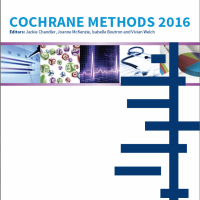
Abridged version of a Cochrane Methods editorial by Sally Hopewell, editor Methodology Review Group.
Cochrane Methods has come of age. This the last paper issue as we move towards delivering content via an open access peer-reviewed, a Cochrane Methods section in the Cochrane Database of Systematic Reviews (CDSR). As a section of the CDSR, it will gain, and contribute to, the CDSR impact factor while continuing to publish high quality methods research.
The need for exemplary research evidence is central to Cochrane and the methodology of Cochrane Reviews has progressed since the formal launch of The Cochrane Collaboration in 1993. High quality systematic reviews demand the development of high quality systematic review methodology. Thus we can trace the evolution of the methodology of systematic reviews back to the first Cochrane Handbook in 1994,“Preparing and Maintaining Systematic Reviews” through to the first published print copy Version 5 in 2008, “The Cochrane Handbook for Systematic Reviews of Interventions”. We continue to work towards updating the Cochrane Handbook.
Timeline
1997: The Norwegian Branch of the Nordic Cochrane Centre first published the ‘Cochrane Methods Working Groups Newsletter’. It had an internal audience and aimed to provide a mechanism for sharing information about methodological research of relevance to systematic reviews.
2000: The editorial base relocated to Oxford and I became co-editor together with Mike Clarke.
2010: It was redesigned and renamed the Newsletter ‘Cochrane Methods’. Greater prominence was given to the work of Methods Groups within Cochrane and their profiles were raised.
2012: Jackie Chandler took over as technical editor and together with the co-editors she was instrumental in the move towards the new Cochrane Methods section of the CDSR. Our Methods Groups are influential in the development of systematic review methods within Cochrane. The 17 current Methods Groups began with the Statistics Methods Group and the Individual Patient (now ‘Participant’) Data Methods Group in 1994. Our newest group, Rapid Reviews was registered in 2016. These continuing developments reflect the evolution of methodology for conducting Cochrane Reviews. For example, the I2 statistic - which is used to help assess and quantify the consistency of the results of studies in a meta-analysis is now seen routinely at the bottom of a forest plot in Review Manager. ‘Summary of findings’ tables also provide a clear and simple format for readers to access key information about review findings.
Despite this progress it is important that methods continue to evolve and develop to meet the needs of our end users. Cochrane is beginning to address different types of systematic review questions, e.g. diagnostic test accuracy and Overviews of Cochrane Reviews. Increasingly, our reviews include different types of data, e.g. non-randomized studies, economic data and and qualitative studies.
Cochrane needs to continue to progress and invest as new methodology evolves into areas such as indirect comparisons and multiple treatment meta-analyses. Advancements in technology will require Cochrane to think about modernising its existing methods, possibly by streamlining the process of systematic review production– currently being tested by Project Transform. So the new section in the CDSR will provide a unique vehicle for show-casing advancing methods in systematic reviews and evidence synthesis in the years to come!
